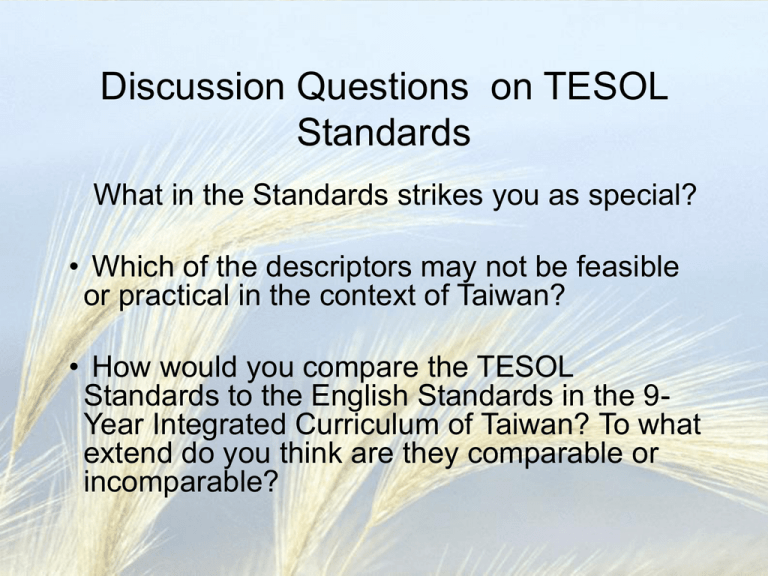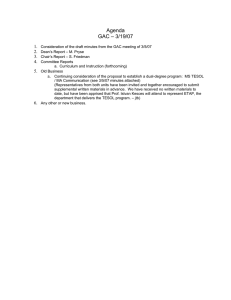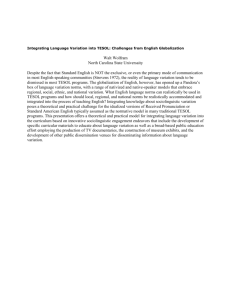Discussion Questions on TESOL Standards
advertisement

Discussion Questions on TESOL Standards What in the Standards strikes you as special? • Which of the descriptors may not be feasible or practical in the context of Taiwan? • How would you compare the TESOL Standards to the English Standards in the 9Year Integrated Curriculum of Taiwan? To what extend do you think are they comparable or incomparable? TESOL Standards for ESOL Learners • Goal 1: To use English to communicate in social settings. Standard 1: Students will use English to participate in social interaction. Standard 2: Students will interact in, through, and with spoken and written English for personal expression and enjoyment. Standard 3: Students will use learning strategies to extend their communicative competence. TESOL Standards for ESOL Learners Goal 2: To use English to achieve academically in all content areas. Standard 1: Students will use English to interact in the classroom. Standard 2: Students will use English to obtain, process, construct, and provide subject matter information in spoken and written form. Standard 3: Students will use appropriate learning strategies to construct and apply academic knowledge. TESOL Standards for ESOL Learners Goal 3: To use English in socially and culturally appropriate ways. Standard 1: Students will choose a language variety, register, and genre according to audience, purpose, and setting. Standard 2: Students will use non-verbal communication appropriate to audience, purpose, and setting. Standard 3: Students will use appropriate learning strategies to extend their sociolinguistic and sociocultural competence. TESOL Standards: Goal 1, Standard 1 • To use English to communicate in social settings: Students will use English to participate in social interactions • Descriptors –sharing and requesting information –expressing needs, feelings, and ideas –using nonverbal communication in social interactions –getting personal needs met –engaging in conversations –conducting transactions TESOL Standards: Goal 1, Standard 2 • To use English to communicate in social settings: Students will interact in, through, and with spoken and written English for personal expression and enjoyment • Descriptors – describing, reading about or participating in a favorite activity – sharing social and cultural traditions and values – expressing personal needs, feelings, and ideas – participating in popular culture TESOL Standards: Goal 1, Standard 3 • To use English to communicate in social settings: Students will use learning strategies to extend their communicative competence • Descriptors –testing hypotheses about language –listening to and imitating how others use English –exploring alternative ways of saying things –focusing attention selectively –seeking support and feedback from others (continues on next slide) TESOL Standards: Goal 1, Standard 3 • To use English to communicate in social settings: Students will use learning strategies to extend their communicative competence • Descriptors –comparing nonverbal and verbal cues –self-monitoring and self-evaluating language development –using the primary language to ask for clarification –learning and using language "chunks" –selecting different media to help understand language –practicing new language –using context to construct meaning TESOL Standards: Goal 2, Standard 1 • To use English to achieve academically in all content areas: Students will use English to interact in the classroom • Descriptors –following oral and written directions, implicit and explicit –requesting and providing clarification –participating in full class, group, and pair discussions –asking and answering questions –requesting information and assistance –negotiating and managing interaction to accomplish tasks –explaining actions –elaborating and extending other people's ideas and words –expressing likes, dislikes, and needs TESOL Standards: Goal 2, Standard 2 • To use English to achieve academically in all content areas: Students will use English to obtain, process, construct, and provide subject matter information in spoken and written form. • Descriptors –comparing and contrasting information –persuading, arguing, negotiating, evaluating, and justifying –listening to, speaking, reading, and writing about subject matter information –gathering information orally and in writing –retelling information –selecting, connecting, and explaining information (continues on next slide) TESOL Standards: Goal 2, Standard 2 • To use English to achieve academically in all content areas: Students will use English to obtain, process, construct, and provide subject matter information in spoken and written form. • Descriptors – analyzing, synthesizing, and inferring from information – responding to the work of peers and others – representing information visually and interpreting information presented visually – hypothesizing and predicting – formulating and asking questions – understanding and producing technical vocabulary and text features according to content area – demonstrating knowledge through application in a variety of contexts TESOL Standards: Goal 2, Standard 3 • To use English to achieve academically in all content areas: Students will use appropriate learning strategies to construct and apply academic knowledge. • Descriptors – focusing attention selectively – applying basic reading comprehension skills such as skimming, scanning, previewing, and reviewing text – using context to construct meaning – taking notes to record important information and aid one's own learning – applying self-monitoring and self-corrective strategies to build and expand a knowledge base – determining and establishing the conditions that help one become an effective learner (e.g., when, where, how to study) (continues on next slide) TESOL Standards: Goal 2, Standard 3 • To use English to achieve academically in all content areas: Students will use appropriate learning strategies to construct and apply academic knowledge. • Descriptors – planning how and when to use cognitive strategies and applying them appropriately to a learning task – actively connecting new information to information previously learned – evaluating one's own success in a completed learning task – recognizing the need for and seeking assistance appropriately from others (e.g., teachers, peers, specialists, community members) – imitating the behaviors of native English speakers to complete tasks successfully – knowing when to use native language resources (human and material) to promote understanding TESOL Standards: Goal 3, Standard 1 • To use English in socially and culturally appropriate ways: Students will use the appropriate language variety, register, and genre according to audience, purpose, and setting . • Descriptors –using the appropriate degree of formality with different audiences and settings –recognizing and using standard English and vernacular dialects appropriately –using a variety of writing styles appropriate for different audiences, purposes, and settings (continues on next slide) TESOL Standards: Goal 3, Standard 1 • To use English in socially and culturally appropriate ways: Students will use the appropriate language variety, register, and genre according to audience, purpose, and setting . • Descriptors –responding to and using slang appropriately –responding to and using idioms appropriately –responding to and using humor appropriately –determining when it is appropriate to use a language other than English –determining appropriate topics for interaction TESOL Standards: Goal 3, Standard 2 • To use English in socially and culturally appropriate ways: Students will use nonverbal communication appropriate to audience, purpose, and setting. • Descriptors –interpreting and responding appropriately to nonverbal cues and body language –demonstrating knowledge of acceptable nonverbal classroom behaviors –using acceptable tone, volume, stress, and intonation, in various social settings –recognizing and adjusting behavior in response to nonverbal cues TESOL Standards: Goal 3, Standard 3 • To use English in socially and culturally appropriate ways: Students will use appropriate learning strategies to extend their sociolinguistic and sociocultural competence . • Descriptors –observing and modeling how others speak and behave in a particular situation or setting –experimenting with variations of language in social and academic settings –seeking information about appropriate language use and behavior (continues on next slide) TESOL Standards: Goal 3, Standard 3 • To use English in socially and culturally appropriate ways: Students will use appropriate learning strategies to extend their sociolinguistic and sociocultural competence . • Descriptors –self-monitoring and self-evaluating language use according to setting and audience –analyzing the social context to determine appropriate language use –rehearsing variations for language in different social and academic settings –deciding when use of slang is appropriate 基本理念 • 隨著地球村時代的來臨,國際間政治、經濟、文化 往來頻繁,英語的重要性日益突顯。從資訊、科技、 工商業、乃至高等教育,英語已成為國際交流的重 要溝通工具。此外,透過英語文學習,學習者能適 切回應英語國家的社會文化活動和增進多元文化的 了解與尊重,並進而使用英語能力為二十一世紀的 生活作準備,更被引述為世界公民的必要素質。 • 為配合政府國際化的政策,提高我國國際競爭力, 政府正大力推動各個階段的英語教育,加上社會各 界的殷切期盼,英語教學遂規劃九十四學年度起提 前至國小三年級開始實施。 基本理念 • 國民中小學英語課程旨在奠定國人英語溝通能力的基礎、提 昇英語學習的動機與興趣、涵泳國際觀、獲致新知,以期未 來能增進國人對國際事務的處理能力,增強國家競爭力。本 課程強調營造自然、愉快的語言學習環境,以培養學生的學 習興趣和基本溝通能力。上課宜採輕鬆活潑、互動的教學模 式;教材內容及活動設計宜生活化、實用化及趣味化;體裁 宜多樣化。除強調個別語言成分之外,更應強調聽、說、讀、 寫四種技能的培養,透過多元教材與活動練習,循序漸進, 讓學生藉由同儕及師生的互動,多方面接觸英語,並實際運 用,而非由老師單向灌輸文法知識。為了維持學生的學習動 機且不增加學習負擔,教材的份量及難易度宜適中,學生的 學習興趣與吸收能力應勝於教學進度的考量。 課程目標 國民中小學英語課程的目標為: •培養學生基本的英語溝通能力,俾能運用於 實際情境中。 •培養學生學習英語的興趣與方法,俾能自發 有效地學習。 •增進學生對本國與外國文化習俗的認識,俾 能加以比較,並尊重文化差異。 分段能力指標 • 國小階段︰國小三、四、五、六年級。 • 國中階段︰國中一、二、三年級。 • 以上兩階段的教學同時注重聽、說、讀、寫,不過本課程希 望能運用兒童在發音學習方面的優勢,於國小三、四年級的 啟蒙階段強調聽、說的學習,讓兒童藉由豐富的英語聽、說 的學習,奠定良好的英語口語溝通基礎。然而即使是在啟蒙 階段,讀、寫活動並未偏廢,而是適時融入課程,讓學生藉 由接觸簡易的閱讀材料,以及適當的臨摹及填寫字詞等練習, 自然體驗語言的不同形式,以收聽、說、讀、寫四者相輔相 成的效果。國中階段除了持續地培養基本聽說讀寫的能力外, 更強調英語的實際運用,發揮其工具性功能,藉以吸收新知、 幫助個人身心發展。 (續下頁) 分段能力指標 • 本課程的分段能力指標分國小、國中兩階段加以規劃,並依 語言能力、學習英語的興趣與方法、及文化與習俗三方面加 以敘述。其中語言能力的陳述涵括聽、說、讀、寫以及語言 綜合應用能力五項。 ‹說明 › • 能力指標編號:第一個數字代表能力類別,第二個數字代表 學習階段,第三個數字代表流水號。 • 國小階段部份能力指標以斜體字標示者,代表該能力指標較 為基本,應該優先在國小三、四年級達成。 • 九年一貫英語科教學應涵蓋以下所有的能力指標,惟表中標 有 * 號者,表示各校在針對學生的能力特質或各校的不同時 數規劃課程時,可就該項能力指標選取或自行研發深淺、份 量不同的教材,進行適性教學。 英語能力指標:國小階段(聽) 1-1-1 能聽辨26個字母。 1-1-2 能聽辨英語的語音。 1-1-3 能聽辨課堂中所習得的詞彙。 1-1-4 能聽辨問句和直述句的語調。 1-1-5 能聽辨基本的單字、片語、及句子的重音。 1-1-6 能聽辨句子的節奏。 1-1-7 能聽懂常用的教室用語及日常生活用語。 1-1-8 能聽懂簡單的句子。 1-1-9 能聽懂簡易的日常生活對話。 *1-1-10 聽懂簡易歌謠和韻文的主要內容。 *1-1-11 能藉圖畫、布偶及肢體動作等視覺輔助,聽 懂簡易兒童故事及兒童短劇的大致內容。 英語能力指標:國中階段(聽) 延續國小階段的基礎,繼續發展以下各項力: 1-2-1 能辨識簡易詩歌的節奏與音韻。 1-2-2 能辨識不同句子語調所表達的情緒和態 度。 1-2-3 能聽懂日常生活對話和簡易故事。 *1-2-4 能辨識對話或訊息的主旨或目的。 *1-2-5 能透過視覺上的輔助,聽懂簡易影片和 短劇的大致內容。 英語能力指標:國小階段(說) 2-1-1 能說出26個字母。 2-1-2 能唸出英語的語音。 2-1-3 能說出課堂中所習得的詞彙。 2-1-4 能以正確的語調說出問句和直述句。 2-1-5 能以正確的重音及適當的語調說出簡單的句子。 2-1-6 能使用簡單的教室用語。 2-1-7 能以簡易英語介紹自己。 2-1-8 能以簡易英語介紹家人和朋友。 2-1-9 能使用基本的社交禮儀用語。 2-1-10 能作簡單的提問、回答和敘述。 2-1-11 能吟唱和朗讀歌謠韻文。 2-1-12 能以簡易英語看圖說話。 *2-1-13 能根據圖片或提示以角色扮演作簡單的對話。 *2-1-14 能參與簡易的兒童短劇表演。 英語能力指標:國中階段(說) 延續國小階段的基礎,繼續發展以下各項能力: 2-2-1 能使用主要的教室用語。 2-2-2 能以簡易英語參與課堂上老師引導的討論。 2-2-3 以簡易的英語表達個人的需求、意願和感受。 2-2-4 能以簡單的英語描述日常生活中相關的人、事、物。 2-2-5 能依人、事、時、地、物作提問和回答。 *2-2-6 能依情境及場合,適切地表達自我並與他人溝通。 *2-2-7 能參與簡易的短劇表演。 *2-2-8 能以簡單的英語介紹國內外風土民情。 英語能力指標:國小階段(讀) 3-1-1 3-1-2 3-1-3 3-1-4 3-1-5 3-1-6 3-1-7 能辨識印刷體大小寫字母。 能辨識課堂中習得的詞彙。 能使用字母拼讀法(phonics)中基本常用的規則讀出單字。 能看懂簡易的英文標示。 能辨識故事、韻文、歌謠中的常用字詞。 能看懂簡單的句子。 能了解英文書寫格式,如字間空格、句首大寫、由左到 右、上而下及句尾適當標點符號。 3-1-8 能跟著老師或錄音帶正確地朗讀課本中的對話和故事。 *3-1-9 能藉圖畫、圖示等視覺輔助,閱讀並了解簡易故事及 兒童短劇中的大致內容。 *3-1-10 能藉圖畫、書名或上下文做簡易的預測或推論。 *3-1-11 能活用字母拼讀法(phonics)的規則讀出單字。 英語能力指標:國中階段(讀) 延續國小階段的基礎,繼續發展以下各項能力: 3-2-1 能辨識英文字母的連續書寫體 (cursive writing)。 3-2-2 能用字典查閱字詞的讀音及意義。 3-2-3 能看懂常用的英文標示和圖表。 3-2-4 能用適切的語調、節奏朗讀短文、故事等。 3-2-5 能了解課文的主旨大意。 3-2-6 能了解對話、短文、書信、故事及短劇等的重要內容與 情節。 *3-2-7 能辨識故事的要素,如背景、人物、事件和結局。 *3-2-8 能從上下文或圖示,猜字意或推論文意。 *3-2-9 能閱讀不同體裁、不同主題的簡易文章。 *3-2-10 能了解並欣賞簡易的詩歌及短劇。 英語能力指標:國小階段(寫) 4-1-1 4-1-2 4-1-3 4-1-4 4-1-5 能書寫印刷體大小寫字母。 能書寫自己的姓名。 能臨摹抄寫課堂中習得的詞彙。 能臨摹抄寫課堂中習得的句子。 能拼寫一些基本常用字詞(至少一百八 十個)。 4-1-6 能依圖示填寫重要字詞。 4-1-7 能掌握英文書寫格式寫出簡單的句子。 英語能力指標:國中階段(寫) 延續國小階段的基礎,繼續發展以下各項能力: 4-2-1 能填寫簡單的表格及資料等。 4-2-2 能依提示合併、改寫及造句。 4-2-3 能寫簡單的賀卡、書信(含電子郵件) 等。 *4-2-4 能依提示書寫簡短的段落。 英語能力指標:國小階段(綜合) 5-1-1 5-1-2 5-1-3 5-1-4 能正確地辨識、唸出與寫出26個英文字母。 能聽懂及辨識課堂中所習得的英語詞彙。 在聽讀時,能辨識書本中相對應的書寫文字。 口語部份至少會應用三百個字詞,書寫部份至 少會拼寫其中一百八十個字詞,以應用於簡易 的日常溝通中。 5-1-5 能聽懂日常生活應對中常用語句(如問候、致 謝、道歉、道別等),並能作適當的回應。 *5-1-6 能依文字或口語提示寫出重要字詞。 5-1-7 能活用字母拼讀法(phonics)了解英語拼字與發 音間規則的對應關係,並能嘗試看字發音,聽 音拼字。 英語能力指標:國中階段(綜合) 延續國小階段的基礎,繼續發展以下各項能力: 5-2-1 畢業時,學生應至少學會一千二百個字詞,並 能應用於聽、說、讀、寫的溝通中。 5-2-2 能轉述別人簡短的談話。 5-2-3 能聽懂日常生活對話、簡易故事或廣播﹐並能 以簡單的字詞、句子記下要點。 5-2-4 能看懂故事及簡易短文,並能以幾個簡短的句 子述說或寫出內容大意。 *5-2-5 能看懂日常溝通中簡易的書信、留言或賀卡、 邀請卡等,並能以口語或書面作簡短的回應。 *5-2-6 能看懂並能填寫簡單的表格、資料。 *5-2-7 能翻譯簡易的中英文句子。 英語能力指標:國小階段(興趣與方法) 6-1-1 6-1-2 6-1-3 6-1-4 6-1-5 樂於參與各種課堂練習活動。 樂於回答老師或同學所提的問題。 對於老師的說明與演示,能集中注意。 主動溫習、預習功課。 運用情境中非語言訊息,如圖示、肢體 動作、語調、表情等幫助學習。 6-1-6 樂於接觸課外英語教材。 6-1-7 不畏犯錯,樂於溝通、表達意見。 6-1-8 主動向老師或同學提出問題。 英語能力指標:國小階段(興趣與方法) 6-1-9 在生活中有使用英語機會時,樂於嘗試。 6-1-10 在生活中接觸英語時,樂於探究其涵意並嘗試 模仿。 6-1-11 運用已學過字詞之聯想以學習新的字詞。 6-1-12 樂於參與有助提昇英語能力的活動 (如英語營、 詩歌朗誦、短劇表演或比賽等)。 *6-1-13 具有好奇心,並對老師或同學討論的內容能 舉出示例或反例。 6-1-14 主動做完老師交待的作業。 *6-1-15 主動查閱圖畫字典。 *6-1-16 會在生活中或媒體上注意到學過的英語。 英語能力指標:國中階段(興趣與方法) 以國小階段的學習興趣與方法為基礎,進一步加以提升增強: 6-2-1 樂於接觸英語電影、歌曲、廣播、書籍等。 6-2-2 對於世界各地民情文化有興趣,並樂於找機會 接觸。 *6-2-3 樂於嘗試閱讀故事、雜誌及其他課外讀物。 6-2-4 了解基本英文閱讀技巧,進而提升閱讀的興趣 與能力。 6-2-5 對於教學內容能主動複習並加以整理歸納。 *6-2-6 利用簡單工具書(如字典),主動了解所接觸英 語的內容。 *6-2-7 主動從網路或其他課外材料搜尋相關的教學 資源,與老師及同學分享。 英語能力指標:國小階段(文化與習俗) 7-1-1 能認識課堂中所介紹的國內外主要節慶 習俗。 7-1-2 能了解我國主要節慶的簡易英語表達方 式。 7-1-3 能了解一些國際社會的基本禮儀。 7-1-4 能認識外國風土民情。 英語能力指標:國中階段(文化與習俗) 以國小階段對文化習俗的了解為基礎, 進一步發展以下知能: *7-2-1 能以簡易英語介紹中外風土民情。 *7-2-2 能了解國際社會的基本說話禮儀。 *7-2-3 能從多元文化觀點,了解並尊重不同的 文化及習俗。

